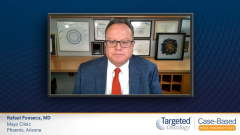
Phase 3 MAIA Trial Review
Rafael Fonseca, MD, reviews efficacy and safety data from the phase 3 MAIA trial and discusses their implications for clinical practice.
Rafael Fonseca, MD: What about patients who are not eligible for stem cell transplant? We’ve learned from SWOG that 3 drugs were better than 2. I’ve previously mentioned RVd [lenalidomide, bortezomib, dexamethasone] is better than Rd [lenalidomide, dexamethasone] and satisfies all the tenants of evidence-based medicine. But another study you’re familiar with, MAIA, was updated as well at the recent ASH meeting by my colleague Dr Shaji Kumar. The regimen really shows outstanding results with very prolonged duration of progression-free survival. In fact, it hasn’t been reached. What we’re finding is that the regimen seems to be at least as effective as what we have seen with the RVd [lenalidomide, bortezomib, dexamethasone] backbone, perhaps more. If there was a head-to-head comparison, I predict the Rd backbone regimen would come out ahead. However, the major advantage is that we don’t have the complication of peripheral neuropathy, so this becomes a very attractive regimen.
Another regimen that has been published and is not as relevant to the United States, but is relevant because of the principles, is the ALCYONE clinical trial. ALCYONE combined the regimen VMP [bortezomib, melphalan, prednisone] that was developed by the team of Dr María-Victoria Mateos vs VMP [bortezomib, melphalan, prednisone] plus daratumumab [Darzalex] with great results and with superiority for the 4 drugs. After we move more into the future, I anticipate that for the majority of patients who are not eligible, they will receive at least 3 drugs, 1 being the monoclonal antibody. The next question would be, what about 4 drugs, as was the case in our particular patient? We’ll continue to look at the data, but the reality is that our ability to control myeloma in this patient population is much better than it has ever been. With duration of disease control that will often exceed 5 years, a patient starts thinking about time to next treatment.
All of what I’m telling you for frontline therapy matters in what we do for a subsequent line of treatment: a first or a second relapse. I’ve been quite vocal about the idea of putting your best treatment forward, in particular because of very high rate of attrition between the various lines of treatment in multiple myeloma. We did a study where we looked at the large number of patients who are not transplant eligible and asked ourselves, of those that complete 1 line of therapy, how many of them are able to complete the subsequent line of therapy? The answer is consistently 50%. So it’s a 50% attrition per line of therapy.
As we think about what to use up front, my only advice is to use the best drugs possible. Don’t save your dry powder. Don’t save something for later because that later may not exist for that particular patient. We don’t have all the answers. We still have unmet needs in multiple myeloma, and we have gaps. But the reality is that with the advent of all these drugs, we have better, deeper, and more durable ways to control the disease. Thank you very much.
Transcript edited for clarity.
Case: A 77-Year-Old Woman with Multiple Myeloma
Initial Presentation
- A 77-year-old woman presents with decreased appetites, fatigue, and back pain
- PMH: unremarkable
- PE: pain during ambulation, point tenderness on palpation of the mid-back
- ECOG 1
Clinical Workup
- Hb 9.2 g/dL, corrected calcium 11.8 mg/dL, LDH 285 U/L, creatinine 2.1 mg/dL, albumin 3.8 g/dL, CrCl 45 mL/min
- Peripheral blood smear showed rouleaux formation
- Beta-2 microgloblulin 4.2 mcg/mL, M-protein 2.5 g/dL
- Lambda free light chains: 0.7 mg/dL, kappa free light chains: 13.3 mg/dL
- FISH: hyperdiploid
- UPEP: M-spike of 410 mg of lambda light chains in 24 hours
- PET/CT revealed lytic bone lesions in at L2/L3
- Bone marrow biopsy shows 60% plasma cells IgG k
- Diagnosis: R-ISS stage II MM
Treatment
- Patient is ineligible for ASCT due to comorbidities
- Initiated treatment with daratumumab + bortezomib + lenalidomide + dexamethasone









































